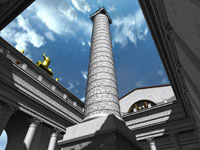|
|
 |
|
Trajan's Column and Forum: Immortality and Memory |
|
written
by shivali / 09.06.2005 |
|
|
| |
Patron |
| |
| |

|
| http://student-kmt.hku.nl/~joost1/forumtrajani/Plaatje%20-%20zuil%20omhoog.jpg |
| Viewing the Column |
| Viewing Trajan's Column was especially difficult from the small courtyard. |
| |
|
There are several architectural difficulties to overcome to view the Column of Trajan. To read the story, the viewer must physical circle the Column, making following the narrative quite difficult. First, it is often tricky to keep one's place in the story horizontally. Secondly, the carvings become increasingly difficult to view as one moves up the Column. Finally, the size of the courtyard would have prevented the viewer from moving backward far enough to view the Column in its entirety. Scholars have been unable to determine why such inextricably detailed story would be told in a manner which would be largely unappreciated by the viewer. Some believe that in ancient times, viewers would have used the balconies of the flanking libraries to see the upper portions of the Column. Other historians believe that the primary function of the Column of Trajan was accomplished by the viewing station. They believe that the Roman public at the time would have be informed about the events of the war and visualizing the details of the narrative would have been secondary to the view of city.
Recent academic dialogue and the Column’s architectural design suggests that Trajan may have intended the Column to function as a funerary monument as well. Memory in Roman history offers man immortality. Through sculptures, monuments, and great works of art, exceptional artists and leaders are remembered by citizens with each viewing of the piece. In order to understand the freize of the Column, a viewer must know Trajan and his military feats. Because Trajan's ashes were placed at the base of the Column, scholars like Penelope J. Davies believe that it was meant to serve as a funerary monument. Common Roman procedure denied an Emperor the right to a public burial until the Senate decreed it after his death. Therefore, it is interesting to consider whether Trajan could have anticipated and planned for his burial at the site of the Column. In Davies essay entitled, “Trajan's Column and the Art of Commemoration,” she states that the original design of the Column has a chamber at the base specifically made to house Trajan's ashes. If the Column was intended to serve as a funerary monument, circumambulation is appropriate. Consider that in Ancient Roman, encircling the funeral pyres was an essential part of the burial ritual. Therefore, it is possible that Trajan intended to use the Column as his burial site as well as for propagandistic and commemorative purposes. Davies says a tomb, “ may be monumental and unusual, but it has meaning only through those who look at it; it may speak, but it is always dependent on the passerby to read it aloud, and in a glance or the voice of the living lies perpetuation through memory…” To have no lasting monument which bears his name and records his feats would have meant a truly finite death of Trajan to future generations. But to understand the intricate details of the frieze which surrounds the Column requires an understanding of Trajan and the War. To read the story, the viewer must move around the Column. By controlling the viewer's physical movement, the Column forces active participation. Encirclement of the Column has a dual meaning: it essentially forces viewer reenactment of the ancient burial processions in addition to acting a military propaganda. Thus, the Column of Trajan is memorable to each of its viewers. It is a distinct piece of art amidst the more commonplace statues and monuments.
|
| |
|
| |
|
|
 |
|

